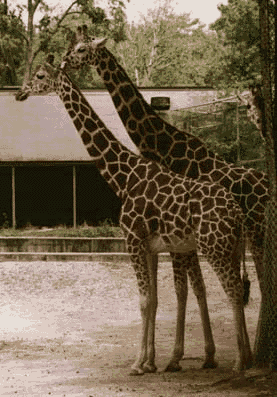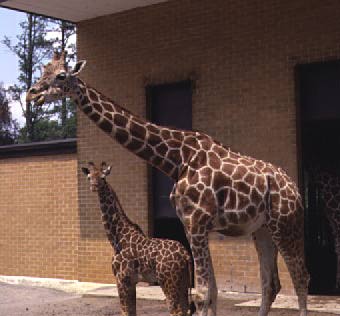


The giraffe is the biggest ruminant and the tallest mammal. The giraffe's scientific name, camelopardalis, is the Latin version of cameleopard. When they were first brought to Rome in 46 B.C., they were thought to be as big as a camel, with spots like a leopard. Although we've long since learned the giraffe is not a combination of these animals, the name stuck. It has a very long neck with short, upstanding mane, high shoulders sloping steeply to hindquarters; long legs nearly equal in length. Male weight is in the range of 2420-4250 lb, shoulder ht 9-11 ft, top of horns up to 18 ft. Female weight 1540-2600 lb, female shoulder ht 2ft shorter. Head tapers to point; long prehensile tongue. The horns are solid bone, skin covered; a main pair in both sexes. The females is thin and tufted while the male's is thick and bald on top, up to 5 in. A median horn and 4 or more smaller bumps in males. Tail hocklength, with long tassel. Color brown to rich chestnut (old males darker, even black), dissected into intricate tapestry by patches and blotches of lighter hair, pattern unique in each giraffe. Scent glands: possible glands on eyelids, nose, lips; adult males may have pungent smell.
The giraffe lives where it is formerly arid and dry. Places like the savanna zones of the Sahara, wherever trees occur. It has been eliminated from most of the West Afican and southern Kalahari range but is still reasonably common even outside wildlife preserves.
Equipped to exploit a 6 foot band of foliage beyond reach of all other terrestrial browsers except the elephant. The 18 incg tongue and a modified atlas-axis joint that lets the head extend vertically further increase the height advantage. Giraffes can browse crowns of small trees. They feed mainly on broad leafed deciduous foliage in the rains and on mainstays in most areas. Narrow muzzle and flexible upper lip, along with the prehensile tongue, enable this animal to harvest the most nutritous leaves in a quantity of up to 75 lb per day. This is necessary for it to maintain its great bulk. Giraffes drink every 2 to 3 days when water is available but also extracts water from the green leaves. It spends the dry season near evergreen vegation. as along watercourses, dispersing more widely in the rains.
The giraffe is nonterritorial and sociable, living in loose, open herds. At any given moment a giraffe may be in a herd composed of all males, all females, females and young, or of both sexes and all ages or all alone if it is a mature bull or a cow guarding a new calf. There are no leaders and minumum coordination of herd movements. Their height and excellent eyesight enable giraffes to maintain a visual contact at long distances. Even at rest, herd members stay over 20 yards apart. As usual, females are more sociable than males. They are rarely out of sight of other females.
A giraffe has just 2 gaits walk and gallop. The lower legs and short trunk decree an ambling walk, with the entire weight supported alternately on left and right legs, as in camels. The long neck moves in synchrony to maintain balance. In galloping (top speed 37 mph), forelegs and hind legs work in pairs like a running rabbit's. To drink, a giraffe must either straddle or bend its forelegs.
From 50% to 75% of calves fall prey to lions and spotted hyenas the first few months, despite hiding and the mother's determined defense. As adults are too big to be regular prey, a mother will stand over and defend her calf against lions, which run the risk of being kicked to death if they get within striking distance. Females never use their horns, and males only use their in contests with peers.
The idea that giraffes are mute is diffiently a myth. Though normally silent, calves bleat and make a mewing call, cows seeking lost calves bellow, and courting bulls emit a raucous cough. Giraffes also give alarm snorts, and moaning, snoring, hissing, and flutelike sounds have been reported.
Males are the only ones who fight. Females, do not spar or fight. There arre six steps that take place before and during the fight. The first step is the Challenger makes nonchalent approach, stands facing oppenent in stiff position. The winner of a sparring contest can be told by if one stands erect or is taller than the other. The second step is if the opponent responds in kind, they have a confrontation. They move stiff legged.
Newborn calves begin their lives by falling 6 feet to the ground. Fortunately, a baby giraffe is generally 6 feet tall and can stand soon after birth. For the first four to five months, calves congregate in nursery groups called creches to rest and socialize while mothers forage in the distance. Considered one of the most vigilant large game animals, giraffes are highly attuned to danger thanks to their height and keen senses of smell & eyesight. They are also fast and can reach speeds of up to 35 mph. ALthough giraffes are relatively prevalent in most parts of Africa, some populations are threatened by poachers.
The giraffes life span is only 20 to 25 years. Sexual maturity: males mature at about 3.5 years but usually don't breed until 8 years old; females mature at 4 to 5 years old. Gestation: 460 to 465 days. The giraffe's circulatory system is specially adapted to the long neck. They have elastic blood vessels in their neck and head to handle changes in blood pressure due to head swings. The giraffe has a relative, the okapi, that has a much shorter neck. The okapi live in the forests of the Congo and are somewhat solitary animals.
- Giraffes natively live in Africa
- Giraffes do not like to be touched by humans
- Giraffes were in the first zoo
- Giraffes land on their heads when born
- Giraffes have 7 bones in their necks, the same number as humans
- Giraffes eat in the morning and night, but they rest in the afternoon
- Male Giraffes have less hair on their horns than females
- Giraffes' necks and heads weigh 500 pounds
- Giraffes favorite food is a thorny plant, but the horns don't hurt them
- Male giraffes weigh one and a half tons
- Female giraffes weigh 1,100 to 1,200 pounds
- When a giraffe sleeps, it lies down for two to ten minutes, but will only sleep for up to 30 minutes per day
- If a giraffe falls over flat then it can't get back up, it dies
- There are three types of Giraffes. These are Rothschilds, Masai, and Reticulated. They each have distinct patterns
- Male Giraffes can run up to 32 miles per hour, but they get tired fast
- Giraffes tongues are pink and black
- Giraffes have four stomachs, just like cows (their cud needs to travel all the way up the neck)
- Giraffes can grunt, snort, growl, sneeeze, snore, moo, bleet, and cough but they like to stay quiet
- People identify Giraffes by their spots
- Giraffes natively live only in Africa